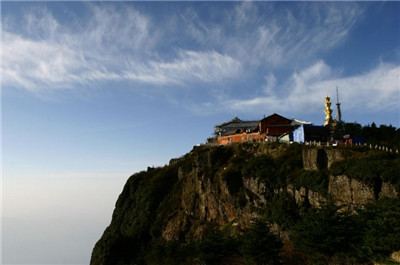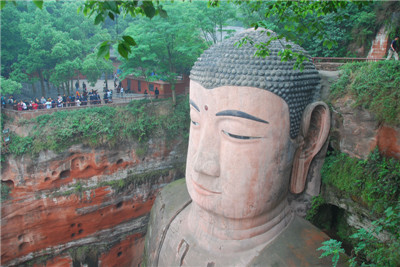Mt. Einei and Leshan Giant Buddha
峨眉山—乐山大佛
自然概况
Mt. Emei Scenic area includes Leshan Giant Buddha ,and it is located in Emeishan City of Sichuan Province with the Giant Buddha sitting at the confluence of Minjiang,Dadu,and Qingyi rivers.
峨眉山风景名胜区包括乐山大佛,位于四川省峨眉山市乐山大佛位于峨眉山以东的眠江、大渡河、青衣江广江汇流处。
Mount Emei rises in the southwestern part of the Chengdu Plain in Emeishan City,with its highest peak being 3 099 meters above sea level. The craggy southern part of the mountain is crisscrossed by ravines and covered with a dense growth of plants,while the northern part features sheer precipices,and waterfalls cascading down the slope.
峨眉山伫立在峨眉山市成都平原的西南部.最高处海拔3 099米、山脉陡峭崎岖的南部河流交错,植被浓密,而北部只有息崖峭壁,瀑布沿着陡崖喷流而下。

Mount Emei is called the"mountain of brightness"in Buddhism. The legend goes that the Guangxiang Temple on the mountain top was where the goddess of benevolence performed Buddhist rituals,thus making it one of the four famous sacred mountains of Buddhism in China. There used to be over100 temples and halls on the mountain,but only some 20 still stand. The Baoguo Temple situated at the foot of the mountain is the largest temple on Mount Emei,built during the Ming Dynasty(13f 8一l (W4).The red copper Huayan Pagoda inside the temple is an important relic for studying Chinese Buddhism. The 14-storyed pagoda is seven meters high and its walls are engraved with more than 4 700 images of Buddha and the full text of the Buddhist Sutra of the Huayan Sect.
佛教中峨眉山叫作“大光明山“,传说山顶的广相寺是慈善女神举行佛教仪式的地方,因此使峨眉山成为“中国佛教四大名山”之一。过去山上约有100多座寺堂,但现在仅存约20座。位于山脚选的报国守建于明朝(1368~1644)年间,是峨眉山上最大的寺庙。该庙庙内红铜色的华严塔是研究中国佛经的重要文物。华严塔共14层,高7米,塔身铸有4 700多个佛像,还刻有《华严经》全文。
The Giant Buddha of Leshan is carved on Lingyun Hill,east of Leshan City,which is not far away from Mount Emei. The solemn Buddha is 71 meters high and its head itself is 14. 7 meters high. Its ear is 6. ? meters long,eye 3.3 meters wide,and shoulder 34 meters wide. Its head is covered with I 021 chignons. Its middle finger is t3.3 meters long,and each of the feet are I I meters long and 8. 5 meters wide。large enough to accommodate more than It>0 people sitting on it. The huge figure sits with his hands resting on his knees,his head reaching the hilltop and his feet the river,occupying the entire hillside.
乐山大佛依乐山市东部距峨眉山不远的凌云山而凿造。庄严的大佛身高71米,头高14. 7米,耳长6. 2米,眼宽3. 3米,肩宽34米:大佛头上:.盘有1 021个发髻,其中指长8.3米,每只脚长11米,宽8.5米,脚面可围坐百人以上。大佛双手抚膝而坐,头与山齐,足踏大江,占据了整个山坡。

Surrounded by the charm of both the mountains and rivers,leshan Giant Buddha integrates both the beauty of a natural heritage and the gems of human culture. In the area of 2.5 square kilometres there are ? sites under Class I state protection and 4 sites under Class II state protection.
乐山大佛景区山水交融,将人文遗产精粹和自然遗产融于一身。在这块2. 5平方公里的区域内,有国家一级保护文物两处、二级保护文物四处。
The Giant Buddha faces the historic and cultural Leshan City on the other side of the river. The Giant Buddha is the center of the scenic area,and around it,there are a number of sites of interest,such as the Detached Mound from the irrigation system of Dujiang Weir by Li Bing in Qin Dynasty .the cliff-tomb clusters of Han Dynasty,Buddhist figure carvings,pagodas,and temples of Tang and song Dynasties,as well as architectural groups of Ming and Qing Dynasties.
乐山大佛与乐山城隔江相望。景区以大佛为中心,周边有许多风景名胜,如秦蜀守李冰开断的离堆,汉代崖墓群,唐宋佛像、宝塔、寺庙,明清建筑群等等。
Mount Emei and the Leshan Giant Buddha have now been unified into one scenic area and were put on the world cultural and natural heritage lists in 1996.
峨嵋山一乐山大佛已被合为一个景点,并于1996年被列入《世界文化自然遗产》。














